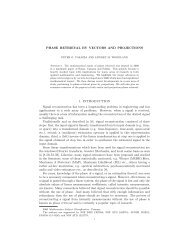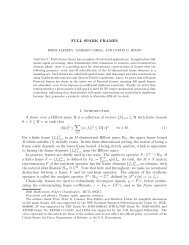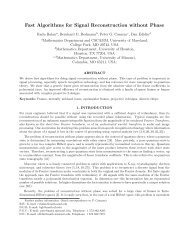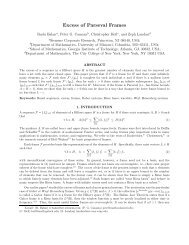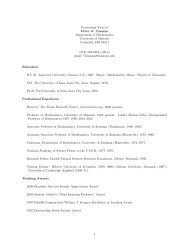Introduction to Finite Frame Theory - Frame Research Center
Introduction to Finite Frame Theory - Frame Research Center
Introduction to Finite Frame Theory - Frame Research Center
Create successful ePaper yourself
Turn your PDF publications into a flip-book with our unique Google optimized e-Paper software.
<strong>Introduction</strong> <strong>to</strong> <strong>Finite</strong> <strong>Frame</strong> <strong>Theory</strong> 13<br />
‖x − Px‖ ≤ ‖x − ˜x‖ for all ˜x ∈ W .<br />
Moreover, if ‖x − Px‖ = ‖x − ˜x‖ for some ˜x ∈ W , then ˜x = Px.<br />
The next result gives the relationship between trace and rank for projections. This<br />
follows from the definition of an orthogonal projection and Corollaries 3 and 5.<br />
Proposition 8. Let P be the orthogonal projection on<strong>to</strong> a subspace W of H N , and<br />
let m = dimW . Then P is orthogonally diagonalizable with eigenvalue 1 of multiplicity<br />
m and eigenvalue 0 of multiplicity N −m. In particular, we have that TrP = m.<br />
3 Basics of <strong>Finite</strong> <strong>Frame</strong> <strong>Theory</strong><br />
We start by presenting the basics of finite frame theory. For illustration purposes,<br />
we then present some exemplary frame classes. At this point, we would also like <strong>to</strong><br />
refer <strong>to</strong> the monographs and books [35, 36, 100, 101, 112] as well as <strong>to</strong> [66, 67] for<br />
infinite-dimensional frame theory.<br />
3.1 Definition of a <strong>Frame</strong><br />
The definition of a (Hilbert space) frame originates from early work by Duffin and<br />
Schaeffer [80] on nonharmonic Fourier series. The main idea, as already discussed<br />
in Section 1, is <strong>to</strong> weaken Parseval’s identity yet <strong>to</strong> still retain norm equivalence<br />
between a signal and its frame coefficients.<br />
Definition 14. A family of vec<strong>to</strong>rs (ϕ i ) M i=1 in H N is called a frame for H N , if there<br />
exist constants 0 < A ≤ B < ∞ such that<br />
A‖x‖ 2 ≤<br />
M<br />
∑<br />
i=1<br />
The following notions are related <strong>to</strong> a frame (ϕ i ) M i=1 .<br />
|〈x,ϕ i 〉| 2 ≤ B‖x‖ 2 for all x ∈ H N . (2)<br />
(a) The constants A and B as in (2) are called lower and upper frame bound for the<br />
frame, respectively. The largest lower frame bound and the smallest upper frame<br />
bound are denoted by A op ,B op and are called the optimal frame bounds.<br />
(b) Any family (ϕ i ) M i=1 satisfying the right hand side inequality in (2) is called a<br />
B-Bessel sequence.<br />
(c) If A = B is possible in (2), then (ϕ i ) M i=1 is called an A-tight frame.<br />
(d) If A = B = 1 is possible in (2) – i.e., Parseval’s Identity holds –, then (ϕ i ) M i=1 is<br />
called a Parseval frame.<br />
(e) If there exists a constant c such that ‖ϕ i ‖ = c for all i = 1,2,...,M, then (ϕ i ) M i=1<br />
is an equal-norm frame. If c = 1, (ϕ i ) M i=1 is a unit-norm frame.



